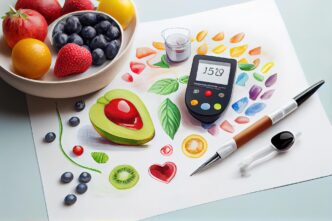A Quick Takeaway
The Story Behind the Trend
How to Make It Work for You
The Community View
Stabilizing blood sugar is a cornerstone of robust health, impacting everything from energy levels and mood to long-term disease prevention. For anyone seeking to optimize their well-being, manage or prevent conditions like type 2 diabetes, or simply maintain consistent energy throughout the day, strategically incorporating specific foods into your daily diet is paramount. These readily available foods, found in any grocery store, work by slowing glucose absorption, improving insulin sensitivity, and providing sustained satiety, ultimately boosting overall health and reducing the risk of chronic illnesses.
Understanding Blood Sugar Stabilization
Blood sugar, or glucose, is the primary sugar found in your blood and the main source of energy for your body. When you eat, carbohydrates are broken down into glucose, which enters your bloodstream. In response, your pancreas releases insulin, a hormone that helps glucose enter your cells for energy or storage.
Maintaining stable blood sugar levels is crucial because frequent spikes and crashes can lead to fatigue, irritability, sugar cravings, and over time, insulin resistance, which is a precursor to type 2 diabetes and other metabolic disorders. Foods that stabilize blood sugar typically have a low glycemic index, meaning they cause a slower, more gradual rise in blood glucose.
Fiber-Rich Powerhouses
Fiber is a non-digestible carbohydrate that plays a critical role in blood sugar management. It slows down the digestion and absorption of sugars, preventing rapid spikes and promoting a steady release of glucose into the bloodstream.
Soluble Fiber Sources
Soluble fiber dissolves in water to form a gel-like substance, which can help lower blood cholesterol and glucose levels. Excellent sources include oats, barley, beans, lentils, apples, pears, and citrus fruits. Regularly consuming these can significantly improve glycemic control.
Insoluble Fiber Sources
Insoluble fiber adds bulk to your stool and helps food pass more quickly through your stomach and intestines. While it doesn’t directly impact glucose absorption as much as soluble fiber, it contributes to overall digestive health and satiety, which can help prevent overeating. Whole grains, nuts, seeds, and leafy green vegetables are rich in insoluble fiber.
Lean Proteins for Sustained Energy
Protein helps to slow down the absorption of carbohydrates and can increase feelings of fullness, reducing the likelihood of overeating and subsequent blood sugar spikes. It also requires more energy to digest, contributing to a stable metabolic rate.
Plant-Based Proteins
For those following a plant-forward diet, lentils, chickpeas, black beans, tofu, tempeh, and quinoa are excellent sources of lean protein. They also often come packed with fiber, offering a dual benefit for blood sugar control.
Animal-Based Proteins
Lean cuts of chicken breast, turkey, fish (especially fatty fish like salmon and mackerel), and eggs provide high-quality protein without excessive saturated fats. These options support muscle maintenance and sustained energy release, crucial for managing blood sugar.
Healthy Fats for Satiety and Regulation
Healthy fats, particularly monounsaturated and polyunsaturated fats, are vital for slowing gastric emptying, which means food stays in your stomach longer, leading to a more gradual release of glucose. They also improve insulin sensitivity, making your body more efficient at using insulin.
Monounsaturated Fats (MUFAs)
Avocados, olive oil, and nuts like almonds, pecans, and cashews are rich in MUFAs. Incorporating these into meals can enhance satiety and provide beneficial compounds for heart health alongside blood sugar benefits.
Polyunsaturated Fats (PUFAs) – Omega-3s
Omega-3 fatty acids, found in fatty fish (salmon, sardines, mackerel), flaxseeds, chia seeds, and walnuts, are known for their anti-inflammatory properties and ability to improve insulin sensitivity. These fats are essential for overall metabolic health.
Non-Starchy Vegetables: Volume and Nutrients
Non-starchy vegetables are incredibly low in calories and carbohydrates but high in fiber, vitamins, and minerals. They allow you to eat large, satisfying portions without significantly impacting blood sugar levels.
Examples
Leafy greens such as spinach, kale, and Swiss chard, along with broccoli, cauliflower, bell peppers, zucchini, and cucumbers, should form the bulk of your meals. They provide essential nutrients and contribute significantly to your daily fiber intake.
Complex Carbohydrates (in Moderation)
While carbohydrates directly impact blood sugar, choosing the right types and quantities is key. Complex carbohydrates are digested more slowly than refined carbohydrates due to their fiber content, leading to a more stable blood sugar response.
Smart Choices
Opt for whole grains like quinoa, brown rice, whole-wheat bread and pasta, and steel-cut oats. Sweet potatoes are another excellent complex carbohydrate option, providing fiber and a wealth of nutrients. Portion control remains important even with these healthier choices.
Berries: Sweetness Without the Spike
Berries are a fantastic fruit choice for blood sugar management. They are naturally sweet but relatively low in sugar compared to other fruits, and packed with fiber and antioxidants. The fiber helps to mitigate any sugar spikes.
Top Picks
Blueberries, strawberries, raspberries, and blackberries offer a delicious way to satisfy a sweet craving while providing valuable nutrients and supporting stable glucose levels. Enjoy them fresh, frozen, or in smoothies.
Building a Balanced Plate
To effectively stabilize blood sugar and enhance your health, focus on creating balanced meals that combine these food groups. Aim for a plate that is half non-starchy vegetables, a quarter lean protein, and a quarter complex carbohydrates, with healthy fats incorporated throughout. Mindful eating, proper hydration, and regular physical activity further complement the benefits of a blood sugar-friendly diet, paving the way for sustained energy, improved mood, and a significantly lower risk of chronic diseases.








